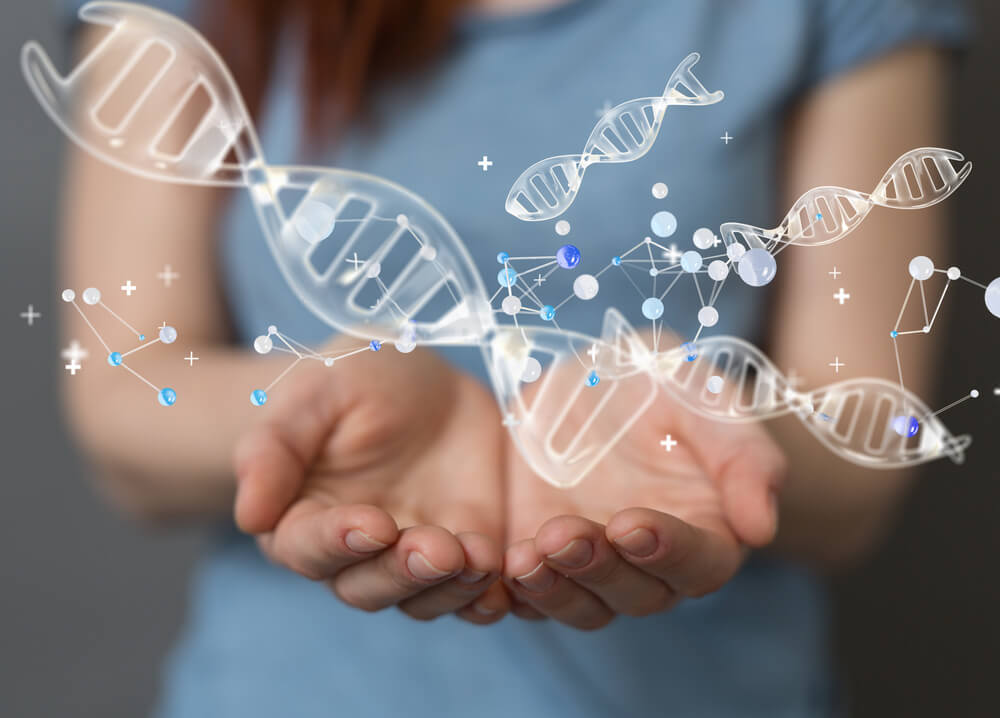By Dian Ginsberg, MD, Board-Certified in OBGYN, Anti-Aging & Regenerative Medicine and Dawn Clark, Futures Architect, AI Systems Designer, Narrative Strategist
A collaboration between medical precision and systems innovation — combining Dr. Ginsberg’s clinical expertise with Dawn Clark’s work in personalized health design and AI-powered care systems.
Quick Summary
Every woman’s hormone journey is unique. Discover how your genetic blueprint shapes midlife symptoms, influences hormone therapy, and opens the door to truly personalized care.
What Your DNA Has to Do With Hot Flashes, Brain Fog, and Energy Shifts
Two women can have nearly identical hormone levels — yet one breezes through perimenopause while the other struggles through sleepless nights, mood swings, or brain fog.
The difference isn’t luck or willpower — it’s written in their genes — and those same genes continue to shape how each woman experiences menopause and beyond.
Your genetic blueprint shapes how your body metabolizes hormones, clears estrogen, and handles stress — and those same pathways determine how you respond to bioidentical hormone therapy (BHRT).
Understanding your genes turns overwhelming data into personal insight — giving you the clarity to make confident, informed choices at every stage of midlife.

The Mystery Between Two Friends
Emma and Claire were close friends who did everything together — Pilates, clean eating, even starting BHRT at the same clinic.
Same age. Same plan. Wildly different results.
Emma felt clear and steady within weeks, while Claire struggled with breast tenderness, bloating, and relentless fatigue.
Their hormone levels looked identical on paper. The difference lay in how their bodies processed those hormones once they were inside.
Emma’s genetic pathways cleared estrogen efficiently. Claire’s ran slow — a hidden “traffic jam” on her hormone highway.

Your Hormone Highway — and Why It Matters
Think of your hormones traveling along a busy highway.
When every lane is open, traffic moves freely — hormones deliver their messages, do their job, and exit gracefully.
But when one lane narrows — because of genetic variants that slow enzyme activity or detox pathways — traffic piles up. Hormones linger longer, creating an estrogen traffic jam — symptoms swell, and signals misfire. That buildup can amplify classic midlife symptoms:
- Bloating and breast tenderness
- Heavy or irregular periods
- Night sweats and mood swings
- Weight that clings around the middle
It’s not that your hormones are “too high.” It’s that your body is processing them differently.

How Your Genes Shape Hormone Balance
A few key genes act like traffic controllers on your hormone highway.
When they work smoothly, hormones move in balance.
When they slow down or get overwhelmed, symptoms often get louder — even when your labs look “normal.”
CYP1A1 — The Smooth Operator
Breaks estrogen into gentler, more easily cleared forms.
- When it’s running well: hormones flow freely and balance feels steady.
- When it’s sluggish: estrogen lingers, leading to dominance symptoms like bloating, breast tenderness, and mood swings.
CYP1B1 — The Risky Detour
Routes estrogen down a more reactive, “sharper-edged” pathway.
- Balanced function: keeps detox clean and inflammation low.
- When overactive: creates more irritating byproducts that can raise inflammation and worsen PMS-like symptoms.
CYP3A4 — The Gatekeeper
Processes hormones and many medications — one of the body’s busiest detox pathways.
- Balanced function: manages estrogen, progesterone, and common medications smoothly, keeping hormone balance steady.
- When overloaded or sluggish: estrogen and certain drugs can accumulate, slowing metabolism and amplifying side effects or sensitivity.
COMT — The Calm Regulator
Clears leftover estrogen and stress chemicals like adrenaline.
- When efficient: mood stays even, sleep comes easier, and stress feels manageable.
- When slow: byproducts build up, fueling anxiety, irritability, or migraines.
MTHFR — The Fuel Line
Feeds your detox pathways with methyl groups from B vitamins.
- When supported: energy stays steady and hormones stay balanced.
- When underpowered: detox slows down, fatigue creeps in, and hormone symptoms intensify.
GST — The Cleanup Crew
Uses glutathione to neutralize and clear estrogen byproducts and toxins.
- When working well: detox runs clean and inflammation stays low.
- When depleted: waste lingers, leading to bloating, fatigue, and greater sensitivity to estrogen.
When these genes work together, hormones cycle gracefully and energy flows.
But when they don’t, signals misfire — and what looks “normal” on paper can feel anything but.
And when these genetic “traffic controllers” start to lag — whether from stress, nutrient gaps, or age-related shifts — the effects ripple outward.
That’s when midlife symptoms begin to feel bigger, louder, and harder to explain — even when your lab results say everything looks fine.
But the story doesn’t begin at menopause. For many women, the first signs appear years earlier.

The Early Signals — and a Smarter Way to Respond
Subtle shifts — like heavier periods, brain fog, irritability, or restless sleep — often show up years before labs flag anything as “off.”
That’s because hormone changes don’t start when estrogen drops; they begin when your genetic pathways start working harder under stress, nutrient gaps, or environmental load.
These early shifts aren’t random; they’re signals — your body’s way of alerting you that detox, stress, and repair systems are overloaded.
And those same systems shape how smoothly your hormones will transition through perimenopause and menopause later on.
Understanding your DNA blueprint early means you can start strengthening those systems now — supporting detoxification, balancing energy, and stabilizing mood long before hormones go into full flux.
It’s not just about symptom relief — it’s about building resilience and longevity from the inside out.
We saw the gap: women feel changes long before traditional medicine offers answers — so we built a smarter bridge.
This program fills what’s been missing: a clear, guided way to decode your genetic blueprint and start feeling better now — not years later.
It’s part of our AI-powered care ecosystem, designed to help you connect the dots between your genes, your hormones, and your daily choices through:
Comprehensive DNA Testing: Interpreted through a precision-medicine lens to reveal how your genes influence hormone detox, nutrition, and energy.
Dr. Ginsberg’s Digital Twin: On-demand video guidance with practical, insights.
Searchable Learning Resources: Explore your genes and recommendations at your own pace.
AI-Supported Care Companion: Searchable guidance to help you make the most of your genes.
This approach supports women at every stage — whether you’re noticing early shifts in your 30s or navigating menopause today.
Because when you understand your blueprint early, you don’t just manage change — you shape your future health.

The Midlife Ripple: When the System Slows Down
As estrogen and progesterone begin to fluctuate, the body leans harder on its detoxification and stress pathways.
If those systems are already sluggish, symptoms can hit harder and last longer.
That’s why one woman glides through perimenopause while another feels like she’s losing control — and it’s also why some women feel worse, not better, on standard HRT.
Why Standard HRT Isn’t One-Size-Fits-All
For women in perimenopause or menopause, most hormone therapy is prescribed based on basic lab levels and symptoms. But those numbers don’t reveal how your body breaks hormones down once you take them.
For women with slower detox genes, even a “normal” dose can cause estrogen buildup — leading to headaches, breast tenderness, and emotional swings. For fast metabolizers, the same dose may clear too quickly, leaving fatigue and fog.
“When you understand your genetic blueprint, you stop guessing — and start healing with precision.”
Compounded, personalized BHRT changes that equation. When guided by your genetic insight, it’s not about “more” or “less” estrogen — it’s about matching your unique rhythm.

Working With Your Genes: Everyday Actions That Change the Story
Your genes don’t dictate your destiny — they define your starting point.
What happens next is shaped by how you eat, move, rest, and recover.
That’s the power of epigenetics: your daily choices can turn genetic switches on or off, influencing everything from hormone balance to cellular repair.
Here’s how to work with your body — not against it:
Food as a Switchboard: Cruciferous vegetables (broccoli, kale, cauliflower) activate estrogen-clearing enzymes.
Movement as Momentum: Exercise boosts circulation through the liver and gut, helping hormones clear faster.
Stress as a Traffic Jam: High cortisol clogs the same pathways that process estrogen.
Nutrients as Helpers: B-vitamins, magnesium, and antioxidants like glutathione keep detox pathways flowing.
When your daily habits align with your genes, symptoms ease, energy returns, and long-term resilience builds — often even before hormone therapy begins.
This isn’t about fixing what’s “wrong.”
It’s about aligning your choices and your environment with your DNA — using science as your map toward optimal health.

Precision Medicine in Action
When we look at your genetics, we’re not just reading letters on a page — we’re mapping how your body processes hormones, stress, and nutrients in real life.
Each test reveals where your system flows easily, and where it needs support.
If your estrogen-detox genes run slow, we focus on liver and gut support, cruciferous vegetables, and gentle BHRT dosing.
If COMT or MTHFR variants show up, we emphasize stress resilience, methylated B vitamins, and targeted nutrient pathways.
If oxidative stress pathways (like GST) are under pressure, antioxidants and detoxification support move up the priority list.
This isn’t about fixing you — it’s about aligning care with your biology.
Data is power — but only when decoded with expertise and care.
That’s why we created the DNA Launchpad, a guided experience that bridges your results to real understanding.
It’s where data becomes personal — with Dr. Ginsberg’s insights, companion videos, and step-by-step tools that help you connect the dots between your genes, your hormones, and your daily choices.
Because real precision medicine doesn’t end with a lab report — it begins with understanding you.
Next Steps: Discover Your DNA Blueprint
Your hormones don’t exist in isolation — they work in concert with your genes, your lifestyle, and the stressors you face every day. When you understand your genetic blueprint, you stop guessing and start making choices that truly move the needle.
That’s the heart of what we do. In your consultation, we connect the dots between your DNA, your lab work, and your lived experience. Together, we design a care plan that feels less like trial-and-error — and more like your personal roadmap back to balance.
Because when your hormones and your genes are working together, you’re not just managing symptoms — you’re reclaiming energy, clarity, and confidence in every part of your life. Click here to book your appointment.
About the Authors
Dr. Dian Ginsberg, MD
Dr. Ginsberg brings decades of clinical experience in women’s hormonal health to her practice. Certified in Anti-Aging & Regenerative Medicine, she is a nationally recognized expert in bio-identical hormone therapy and a leading voice in precision midlife care. In collaboration with Dawn Clark, she integrates deep clinical insight into an evolving model of women’s health that blends data, empathy, and innovation.
Dawn Clark
Dawn Clark designs intelligent, human-centered systems that transform how care is delivered and experienced. As the architect behind Precision FemCare’s digital innovation framework, she created the connective architecture linking science, story, and technology — reimagining how women access insight, empathy, and support between appointments. Her work brings depth, design, and emotional intelligence to the future of personalized healthcare.
References
- Henningsen A, et al. Genetic variation in sex hormone pathways and the risk of endometriosis. Hum Reprod. 2018;33(9):1659-1668. doi:10.1093/humrep/dey241. PMC6092108
- Raftogianis R, et al. SULT1A1 genetic variation: Association with age at menopause, estrogen levels, and hormone therapy response. J Clin Endocrinol Metab. 2016;101(7):2644-2652. doi:10.1210/jc.2016-1127. PMC4961269
- Gervaso L, et al. Genetic polymorphisms of CYP3A4 and CYP3A5 in hormone metabolism and cancer risk. Genes (Basel). 2020;11(10):1150. doi:10.3390/genes11101150. PMC7538102
- Andrade JM, et al. Genetic polymorphisms of COMT, FUT2, and perimenopausal health: A minireview. J Pers Med. 2024;14(8):821. doi:10.3390/jpm14080821. PMC11664282
- Long JR, et al. Genetic polymorphisms of estrogen-metabolizing enzymes and breast cancer susceptibility. Int J Cancer. 2012;130(8):1862-1871. doi:10.1002/ijc.26193. PMC3357071
- Almeida M, et al. Influence of estrogenic metabolic pathway genes polymorphisms on postmenopausal breast cancer risk. Pharmaceuticals (Basel). 2021;14(2):94. doi:10.3390/ph14020094. MDPI Link
- Mahmoudi E, et al. Genomics, epigenetics, and the “missing heritability” of complex diseases. Int J Mol Sci. 2017;18(12):2734. doi:10.3390/ijms18122734. PMC5751305
- Gervaso L, et al. Genetic polymorphisms of CYP1B1 and CYP1A1 in hormone metabolism and cancer risk. Genes (Basel). 2020;11(10):1150. doi:10.3390/genes11101150. MDPI Link




